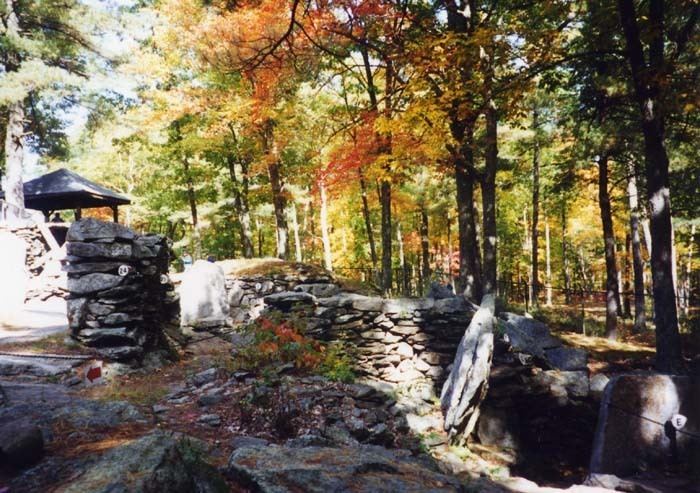Phone +1 603-893-8300 | ||
 | ||
Address 105 Haverhill Rd, Salem, NH 03079, USA Hours Open today · 9AM–5PMTuesday9AM–5PMWednesday9AM–5PMThursday9AM–5PMFriday9AM–5PMSaturday9AM–5PMSunday9AM–5PMMonday9AM–5PM Similar Georgia Guidestones, Canobie Lake Park, Mystery Hill, Gungywamp, The Mall at Rockingham Park Profiles | ||
America s stonehenge nh mystery story review tour
America's Stonehenge is an archaeological site consisting of a number of large rocks and stone structures scattered around roughly 30 acres (120,000 m2) within the town of Salem, New Hampshire in the northeast United States. America's Stonehenge is open to the public for a fee. Part of a recreational area that includes snowshoe trails and an alpaca farm, it is a tourist attraction, with particular appeal to believers in New Age systems.
Contents
A number of hypotheses exist as to the origin and purpose of the structures. One viewpoint is a mixture of land-use practices of local farmers in the 18th and 19th centuries and construction of structures by owner William Goodwin in the 1930s. Claims that the site has pre-Columbian European origins are regarded as controversial, possibly even pseudoarchaeological, or as the result of an early-20th century hoax. Archaeologist David Starbuck has said that "It is widely believed that Goodwin may have “created” much of what is visible at the site today".
The site was first dubbed Mystery Hill by William Goodwin, an insurance executive who purchased the area in 1937. This was the official name of the site until 1982, when it was renamed "America's Stonehenge", a term coined in a news article in the early 1960s. The rebranding was an effort to separate it from roadside oddity sites and reinforce the idea that it is an ancient archaeological site. Although the area is named after Stonehenge in England, there is no cultural connection between the two.
Origin
The site first appears in print in the 1907 History of Salem, N.H. It is described thus: "Jonathan Pattee's Cave. He had a house in these woods 70 years ago; took town paupers before the town farm was bought. This is a wild but beautiful spot, among rough boulders and soft pines, about which the most weird and fantastic tale might be woven. There are several caves still intact, which the owner used for storage purposes." Many believe that Pattee built the site in the nineteenth century. No unequivocal pre-Columbian European artifacts have been found at the site.
The site's history is muddled partly because of the activities of William Goodwin, who became convinced that the location was proof that Irish monks (the Culdees) had lived there long before the time of Christopher Columbus, a concept he sought to publicize. The site has been altered by stone quarrying and by the efforts of Goodwin and others to move the stones to what they considered their original locations, with Goodwin perhaps responsible for much of what can now be seen. Many of the stones have post 1830s drill marks from the quarrying that took place on the site.
While more fanciful origins have also been proposed, artifacts found on the site led archaeologists to the conclusion that the stones were actually assembled for a variety of reasons by local farmers in the 18th and 19th centuries. For example, a much-discussed "sacrificial stone" which contains grooves that some say channeled blood closely resembles "lye-leaching stones" found on many old farms that were used to extract lye from wood ashes, the first step in the manufacture of soap.
Carbon dating of charcoal pits at the site provided dates from 2000 BC to 173 BC, when the area was populated by ancestors of current Native Americans. In archaeological chronology, this places indigenous use of the site into either the Late Archaic or the Early Woodland time periods.
In 1982, David Stewart-Smith, director of restoration at Mystery Hill, conducted an excavation of a megalith found in situ in a stone quarry to the north of the main site. His research team, under the supervision of the New Hampshire state archaeologist, excavated the quarry site, discovering hundreds of chips and flakes from the stone. Both the state archaeologist and Dr. Stewart-Smith concurred that this was evidence of indigenous tool manufacture, consistent with Native American lithic techniques, although no date could be ascertained.
Archaeologist Clive Runnels stated that "If you've got a Bronze Age site in, say, Great Britain, near Stonehenge, you're going to find pottery, tools, evidence of burials, and hearths" and that "No Bronze Age artifacts have been found there, in fact, no one has found a single artifact of European origin from that period anywhere in the New World."
Carbon-14 dates
All dates are uncorrected radio carbon years expressed as Years before Present (BP) with present being defined as the year 1950. A number of them have no clear association with human activity.
In popular culture
American horror writer H. P. Lovecraft, an enthusiast for New England megalith stone sites, is known to have visited Mystery Hill sometime between 1928 and the 1930s. Mystery Hill is popularly attributed as inspiration for Lovecraft's story "The Dunwich Horror". Scholars, however, place Lovecraft's visit too late to have inspired the 1929 story.
The site was featured on an episode of the American History Channel TV series Secrets of the Ancient World which aired on January 14, 2002, and in which Boston University archaeology professor Curtis Runnels refuted the theory that the site was built by Celts in ancient history.
In Search of..., a 1970s show narrated by Leonard Nimoy, did an episode about the site, titled "Strange Visitors". It was referred to as "Mystery Hill".
In the Weird or What? TV series hosted by William Shatner, the "Human Popsicle" episode covered America's Stonehenge and a variety of explanations as to its origin.
In the pseudo-documentary TV series America Unearthed, hosted by Scott Wolter, the episode "Stonehenge in America" dealt with the possible connections of the site to Stonehenge in England and the Phoenician culture.
It is also mentioned briefly in the X-Files episode "Die Hand Die Verletzt".
